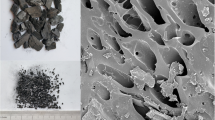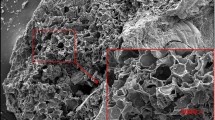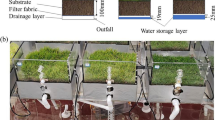Abstract
Green Roofs (GRs) are a promising solution for the reduction of flooding risk in urban areas. Reproducing on the traditional roofs the drainage pattern typical of natural soils, these infrastructures are able to mitigate the stormwater discharged into sewers. Their retention capacity depends on both climate and design variables, among which the substrate and drainage materials seem to play a fundamental role in the enhancement of the efficiency of the roof. This research aimed at analyzing the hydrological behavior of five 15-cm GRs modules, characterized by different substrate and drainage layers soil composition and thickness, using CHEMFLO-2000. Specifically, among the substrate materials particular attention was paid to the biochar, a fertilizer known for its ability to filter pollutant, to assess its effect on the green roof retention capacity. Simulations under different rainfall inputs were carried out to compare the performance of each system.
Access provided by Autonomous University of Puebla. Download conference paper PDF
Similar content being viewed by others
Keywords
1 Introduction
Worldwide, integrated approaches involving Sustainable Drainage Systems (SuDS) are increasingly spreading to support traditional infrastructures in the urban flooding management [1]. Among the types of SuDS, green roofs (GRs) allows making the best use of the roofs waterproof surface, reproducing the drainage pattern typical of natural soil and reducing stormwater runoff [2,3,4]. It is widely known that technological features affect the performance of these systems. Specifically, researchers worldwide agree in recognizing the influence of the GR substrate and drainage materials on the ability of the roof to retain and detain stormwater, consequently reducing peak flows and discharged volumes [5, 6]. However, the variety of soils that make up green roofs with their different characteristics, thickness and disposal may lead to a great variety of findings.
Hence, this study aims at investigating the hydrological performance of five GRs stratigraphic models of 15-cm height, characterized by different substrate and drainage layers soil composition and thickness. In particular, the analyses focused on the assessment of the biochar, a carbonaceous material commonly used as fertilizer and renowned for its ability to filter pollutants and improving the quality of stormwater discharged [7, 8]. The purpose is to understand weather this material, if implemented in GRs, also manages achieving significant results in term of reduction of stormwater quantity as stated by several studies [9,10,11]. To this end, CHEMFLO-2000 simulations helped quantify the hydrological response of the mentioned GR configurations, two of which involving biochar, under four rainfall inputs, characterized by different durations and designed according to the mean precipitation extremes registered at the University of Salerno campus, Italy, where a GR experimental site was set up in 2017. Simulation results were compared in terms of retention capacity.
2 Materials and Methods
2.1 Case Study
The hydrological response of five GR types to four different precipitation inputs was compared in the present study. In general, a green roof is made up of several overlapping layers. In the basic configuration, the system consists of four components including, from the top to the bottom, a vegetation layer, a substrate to support plant growth, a non-woven filter fabric that prevent substrate dropping into the underlying drainage layer and a drainage/storage layer with the function of detaining rainwater (Fig. 1).
The five GR configurations selected in the present study differ in terms of composition and depth of the substrate and storage layers (Fig. 2) even if, in each case, the total thickness of the roof is set on 15 cm. In details, they consist of:
-
1)
10 cm depth loam substrate with an underlying 5-cm depth expanded clay storage layer (GR1);
-
2)
10 cm depth loam substrate with an underlying 5-cm depth sand storage layer (GR2);
-
3)
15-cm depth loam substrate (GR3);
-
4)
5 cm depth loam and 5-cm depth biochar substrate with an underlying 5 cm depth expanded clay storage layer (GR4);
-
5)
7 cm depth loam and 3-cm depth biochar substrate with an underlying 5 cm depth expanded clay storage layer (GR5);
In this study, the vegetation, whose role is not so decisive during the precipitation event as during the inter-storm period, was not examined.
2.2 Description of CHEMFLO-2000, Initial Setting and Input Data
Among the several software used to model the behavior of the GRs [12, 13], CHEMFLO-2000 was chosen in the present work to simulate the hydrological response of the five different GR configurations (Fig. 2) to several rainfall events. CHEMFLO-2000 [14] is an interactive software for simulating water and chemical movement in unsaturated soils developed by the Department of Plant and Soil Sciences of the Oklahoma State University. The governing equation used in this software to describe the one-dimensional water movement in the soils is the partial differential equation proposed by Richards in 1931 [15] that can be expressed as:
Where θ = θ(h) is the volumetric water content, h = h(x, t) is the matric potential, x is the position coordinate parallel to the direction of the flow; t is the time; sin(A) is the sine of the angle A between the direction of flow and the horizontal direction; K(h) is the hydraulic conductivity of the soil at matric potential h; and C (h) is the specific water capacity. In this study, to simulate the vertical flow with x increasing in the downward direction an angle A equal to 90° was chosen.
Among the different possibilities given by the model, van Genuchten [16] mathematical equations were chosen to describe soil water content θ(h) and hydraulic conductivity K(h):
Where θr [v/v] is the residual water content, θs [v/v] is the saturated water content, Ks [cm/h] is the saturated hydraulic conductivity and α [1/cm] and n [-] are both empirical constant representative respectively the inverse of the air-entry suction and the pore-size distribution.
In this modeling study, the upper boundary condition at the beginning of the simulation was controlled by the rainfall rate (cm/h). Subsequently, in order to study the water movement since the end of the precipitation, a new condition was established with a constant flux density equal to zero. A free-drainage was chosen to describe the bottom boundary conditions. Initial values of uniform volumetric water content (cm3/cm3) (SWC) of 0.10, 0.15 and 0.25 were set in each model to test the effect of this variable on overall performance of the GR configurations. These values, never below residual water content θr [v/v] and never exceeding saturated water content θs [v/v], were selected among the soil moisture contents in-between the wilting point and the field capacity of the substrate layer, thus simulating the best condition for plant growth.
The van Genuchten functions parameters (Table 1) for modeling loam and sand used in this study are those suggested by Carsel and Parrish (1988) [17] and they are the default parameters of CHEMFLO-2000 for van Genuchten functions. The parameters for the expanded clay and Biochar were respectively provided by [18] and [19].
For each GR configuration, the model was run using four precipitation inputs different for duration, intensity and cumulative rainfall. The durations selected are representative of the rainfall events registered at the University of Salerno campus, Italy, where an experimental GR was set up in 2017, having the same soil layer composition as the GR1 of the current study. This site is equipped with a meteorological station. From a statistical analysis of precipitation records observed since 2017, rainfall duration according to the maximum, the mode, the mean and median durations were taken into account (respectively 76 h, 1 h, 10 h and 6 h). Cumulate rainfalls corresponding to the selected durations are reported in Table 2. Intensity-duration-frequency curves characteristics of Fisciano in Southern Italy were used to estimate intensities and rainfall amounts associated to the mentioned durations (Table 2).
2.3 Retention Capacity of the GR Configurations
The output file of each of the 60 simulations (5 configuration under 4 rainfall scenarios and under 3 Initial Soil Water Contents) was analysed specifically investigating the cumulative flux (runoff) at x = 15 cm at 24 h from the rainfall end. For each modelled GR configuration, the hydrological performance in term of retention capacity (RC) was then computed as follows [20]:
Where C* is the discharge coefficient, computed as the ratio between the cumulative observed runoff depth and the cumulative observed rainfall depth at the event scale.
3 Results and Discussions
Overall, under 10% initial soil water content (SWC), retention capacity assessment confirm reasonably good performances of all the GRs configurations, achieving an average value of 64.07%. Values range from a minimum of 23.28%, reached in GR2 under the highest intensity rainfall (26.50 mm/h), to a maximum of 99.83%, reached in GR3 under the lowest intensity rainfall (1.45 mm/h). The good efficiency of the modelled grs stratigraphic columns is mainly due to the low initial soil moisture content, close to the wilting point of the loam and set in CHEMFLO-2000 equal to 10%. Looking at Table 3 it is possible to observe that GR4 and GR5, both characterized by the presence of biochar, reached the highest retention performances (69.15 and 66.90% on average respectively). These results proved the potential of this fertilizer, already experienced for improving water quality, in the reduction of stormwater volumes. GR2, characterized by 10-cm loam soil layer and 5-cm sand drainage layer, showed the worst retention performance, still achieving an average retention performance of 55.05%. Comparing this result with those reached by GR1 (65.29% on average), which differ from the previous one just for the drainage material (clay), it is clear that the drainage layer characteristics play a fundamental role in the retention performance of the roof, as stated by several authors [21]. In particular, as it can be observed from Table 1, expanded clay (parameterized according to literature) and sand just differ for ks, saturated conductivity, substantially lower in the first drainage material.
Moreover, the relation between Retention Capacity and rainfall amount was investigated (Fig. 3) to understand weather and to what extent rainfall severity could affect the behaviour of each of the observed GR configurations. Examining Fig. 3 it appears that the GRs retention capacities decrease as the rainfall amount increase. The regression analysis, in fact, found a negative linear relationship between the retention coefficients and the rainfall cumulative.
With the increase of the initial SWC to 15% and 25%, a decrease of the retention performance of the GR configurations can be observed with average values of 54.73% and 33.29% respectively. Even if the negative linear relationship between RC and rainfall cumulative still exists, a larger scattering of the values and consequently lower coefficients of determination can be pointed out (Fig. 4 and Fig. 5). Moreover, the assessment found GR2 much more sensitive than the other configurations to the initial SWC changes with an average RC decrease of 24.48% and 78.11% switching from 10% SWC to 15% and 25% respectively.
The analysis of the runoff delay, representative of the time at which the runoff starts, failed to achieve successful results. Specifically, even if GR2 appears characterized by the lowest delay time and so characterized by a faster stormwater runoff occurrence, no great differences between the configurations under varying rainfall inputs can be detected. The reason behind this can be ascribed to the limits of the software, whose numerical models assume a strictly one-dimensional water flow in the soil.
4 Conclusions
In this paper, the performance of five 15-cm GR modules different for substrate and drainage layer characteristics was investigated under varying rainfall inputs and initial SWC to understand how technological parameters and rainfall characteristics could affect their hydrological performance. Even if all the configurations achieved good performances (64.07% on average under 0.10 SWC), soil characteristics seem to play a fundamental role in the enhancement of GRs performance. Specifically substrate involving the fertilizer biochar reached the highest values of retention capacity (69.15 and 66.90% under 0.10 SWC) confirming that this material, already known for the enhancement of water quality, could be a valid solution also for the reduction of stormwater volumes. Moreover, drainage layers made by expanded clay are for sure preferable to those made by sand, exceeding of about the 10% their RC. In addition, the results of the modeling assessment showed that the total rainfall amount seem to affect GRs RC that decrease with the increase of precipitation amount.
The implementation of multi-dimensional models in the future analyses is essential for simulating a more realistic water movement in the soil. Moreover, the possible occurrence and effect of a capillary barrier between the substrate (finer material) and the drainage layer (coarse material) should also be investigated. Several studies borrowed from other scientific fields, in fact, demonstrated that when a capillary barrier effect acts, there is an inhibition of deep drainage and an increase in water storage [22].
Nonetheless, additional research supported by experimental studies is foreseen to confirm the model-based results obtained so far and to improve the hydrological performance investigation of the GRs.
References
D’Ambrosio, R., Balbo, A., Longobardi, A., Rizzo, A.: Re-think urban drainage following a SuDS retrofitting approach against urban flooding: a modelling investigation for an Italian case study. Urban For. Urban Greening (2014,Under review)
Stovin, V.: The potential of green roofs to manage urban stormwater. Water Environ. J. 24, 192–199 (2010)
Longobardi, A., D’Ambrosio, R., Mobilia, M.: Predicting stormwater retention capacity of green roofs: an experimental study of the roles of climate, substrate soil moisture, and drainage layer properties. Sustainability 11(24), 6956 (2019)
Mobilia, M., Longobardi, A.: Smart stormwater management in urban areas by roofs greening. In: International Conference on Computational Science and Its Applications, pp. 455–463 (2017)
Cascone, S.: Green roof design: state of the art on technology and materials. Sustainability 11(11), 3020 (2019)
Young, T., Cameron, D.D., Sorrill, J., Edwards, T., Phoenix, G.K.: Importance of components of green roof substrate on plant growth and physiological performance. Urban For. Urban Greening 13(3), 507–516 (2014)
Palansooriya, K.N., et al.: Occurrence of contaminants in drinking water sources and the potential of biochar for water quality improvement: a review. Crit. Rev. Environ. Sci. Technol. 50(6), 549–611 (2019)
Blanco-Canqui, H.: Biochar and water quality. J. Environ. Qual. 48(1), 2–15 (2019)
Kuoppamäki, K., Hagner, M., Lehvävirta, S., Setälä, H.: Biochar amendment in the green roof substrate affects runoff quality and quantity. Ecol. Eng. 88, 1–9 (2016)
Qianqian, Z., Liping, M., Huiwei, W., Long, W.: Analysis of the effect of green roof substrate amended with biochar on water quality and quantity of rainfall runoff. Environ. Monit. Assess. 191(5), 1–11 (2019). https://doi.org/10.1007/s10661-019-7466-4
Beck, D.A., Johnson, G.R., Spolek, G.A.: Amending green roof soil with biochar to affect runoff water quantity and quality. Environ. Pollut. 159(8–9), 2111–2118 (2011)
Krasnogorskaya, N., Longobardi, A., Mobilia, M., Khasanova, L.F., Shchelchkova, A.I.: Hydrological modeling of green roofs runoff by Nash cascade model. Open Civil Eng. J. 13(1) (2019)
Mobilia, M., Longobardi, A.: Event scale modeling of experimental green roofs runoff in a mediterranean environment. In: Frontiers in Water-Energy-Nexus–Nature-Based Solutions, Advanced Technologies and Best Practices for Environmental Sustainability, pp. 153–156 (2020)
Nofziger, D.L., Wu, J.: CHEMFLO-2000: Interactive Software for Simulating Water and Chemical Movement in Unsaturated Soils. U.S. Environmental Protection Agency, Washington (2003)
Richards, L.A.: Capillary conduction of liquids through porous mediums. J. Appl. Phys. 1, 318–333 (1931)
Van Genuchten, M.T.: A closed-form equation for predicting the hydraulic conductivity of unsaturated soils. Soil Sci. Soc. Am. J. 44, 892–898 (1980)
Carsel, R.F., Parrish, R.S.: Developing joint probability distributions of soil water characteristics. Water Resour. Res. 24, 755–769 (1988)
Mobilia, M., Longobardi, A.: Impact of rainfall properties on the performance of hydrological models for green roofs simulation. Water Sci. Technol. 81(7), 1375–1387 (2020)
Phillips, C.L., Meyer, K.M., Trippe, K.M.: Is biochar applied as surface mulch beneficial for grassland restoration? Geoderma 375, 114457 (2020)
Mobilia, M., D’Ambrosio, R., Longobardi, A.: Climate, soil moisture and drainage layer properties impact on green roofs in a mediterranean environment. In: Naddeo, V., Balakrishnan, M., Choo, K.H. (eds.) Frontiers in Water-Energy-Nexus–Nature-Based Solutions, Advanced Technologies and Best Practices for Environmental Sustainability Advances in Science Technology and Innovation, pp. 169–171 (2020)
Baryla, A.M.: Role of drainage layer on green roofs in limiting the runoff of rainwater from urbanized areas. J. Water Land Dev. 12–18 (2019)
Reder, A., Pagano, L., Picarelli, L., Rianna, G.: The role of the lowermost boundary conditions in the hydrological response of shallow sloping covers. Landslides 14(3), 861–873 (2016). https://doi.org/10.1007/s10346-016-0753-z
Author information
Authors and Affiliations
Corresponding author
Editor information
Editors and Affiliations
Rights and permissions
Copyright information
© 2021 Springer Nature Switzerland AG
About this paper
Cite this paper
D’Ambrosio, R., Mobilia, M., Khamidullin, I.F., Longobardi, A., Elizaryev, A.N. (2021). How Substrate and Drainage Layer Materials Affect the Hydrological Performance of Green Roofs: CHEMFLO-2000 Numerical Investigation. In: Gervasi, O., et al. Computational Science and Its Applications – ICCSA 2021. ICCSA 2021. Lecture Notes in Computer Science(), vol 12956. Springer, Cham. https://doi.org/10.1007/978-3-030-87010-2_17
Download citation
DOI: https://doi.org/10.1007/978-3-030-87010-2_17
Published:
Publisher Name: Springer, Cham
Print ISBN: 978-3-030-87009-6
Online ISBN: 978-3-030-87010-2
eBook Packages: Computer ScienceComputer Science (R0)









